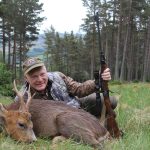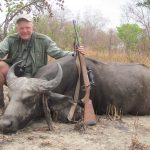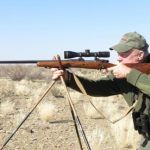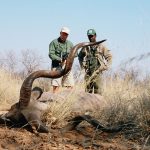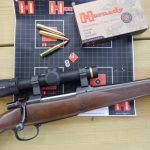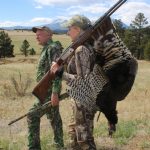How to prepare for the upcoming hunting season.
Here in North America, most hunting seasons are geared around autumn. We American hunters are accustomed to short autumn seasons that we look forward to and plan around. Many European hunters, on the other hand, enjoy a six-month roebuck season spanning spring, summer, and fall. Some African countries have set seasons and others do not, but ideal times generally trend toward either cooler months or the dry season. But here in the U.S., our long-awaited hunting seasons are almost upon us, and we want to be ready!
GET IN SHAPE. Keeping in condition is probably the most time-consuming item on my list. And, as I’m unfortunately learning, the older I get the more constant effort is required. “In shape” is a flexible term, depending heavily on your age and overall health, and just as heavily on the kind of hunting you want to be ready for. Hunting whitetails from stands is probably the most common American hunting situation. You don’t need to be an Olympic athlete, but you need to be able to get to and from your stand and be limber enough to get in and out safely (if not gracefully).
Mountain hunting on foot is a different order of magnitude, and most everything else is somewhere in between. I’m neither a marathon runner nor a personal trainer (and for sure I’ve never had a personal trainer!), but I can offer a few thoughts. First, being in shape for hunting season is not an exam you can cram for. How long it takes depends on your starting point and the level of condition you wish to reach, but we’re talking regular exercise for weeks, perhaps months and even years. Therefore, it’s best to establish some sort of regimen and stick with it, although you can certainly step up your program as a particularly challenging hunt nears.
Second, always see your doctor before starting a new exercise program, and listen to your body. Muscle soreness is normal, but no matter what you’re doing, work up slowly and don’t overdo it: If you hurt yourself, you’re defeating your purpose and delaying your goal.
Distances, difficulty of terrain, and required load varies widely, but most hunting requires at least some walking, at least a light pack, and usually does not require sprinting or long-distance running. Therefore, I am convinced that walking is the best preparation for most hunting. We walk the dog regularly, and pound some of hiking trails near home in the coastal mountains with packs and hiking poles. These days, I strap on knee braces! In between, I go to the gym, focusing on primarily cardio and lifting light weights. Unfortunately, I travel a lot, and travel plays havoc with any fitness schedule. If I can’t do anything better, I jog wherever I am. This year I ran almost daily while in camp in Cameroon, again in Namibia. You need a safe place, but little space and equipment. Walking is as good and maybe better, but takes longer!
I don’t recommend taking up jogging, certainly not without a doctor’s clearance. However, you have to figure out what works for you. I’m too uncoordinated for team sports, I don’t play golf, and traveling with a bike is awkward. Long-term running is hard on the body but, thanks to the Marines, I’ve run all my life. So, when I’m short on time, I strap on my knee braces. These days, I can’t justify my Forrest Gump shuffle as “running”–but, for the purpose, it’s more a matter of time and distance than speed. Again, find exercise you like to do (and thus can make yourself do regularly). Start early and stick with it.
The shooting bench, with the rifle safe and muzzle pointed downrange, is a perfect place to do a careful inspection. Start by making sure all screws are tight, and finish with a thorough function check.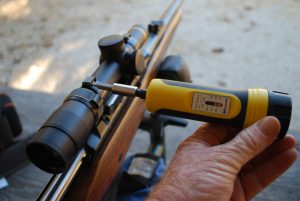
CHECK RIFLE AND AMMO. This shouldn’t take very long, but it can’t be left to the last minute because: What if there’s a problem? Mechanical problems can happen at any time but, typically, they don’t pop up overnight. So, whether Old Betsy has been in storage since last season, or is an old friend that goes to the range often, this final grace period before hunting season is a good time to do a careful butt-to-muzzle inspection. Make sure all screws are tight: Action, scope mounts, and rings.
Obviously, you want to do this in complete safety, so I follow an important member of the “Ten Commandments of Gun Safety” and treat guns as if they’re loaded when I take them out of the safe and make sure they’re cleared and empty. One of my pet peeves is screw-in sling swivel studs that become loose. The problem with loose studs is they tend to keep working looser. If they pop out when the rifle is slung (and they can), then your rifle is likely to take a hard fall. Screw-in studs can usually be re-secured with Loc-Tite or epoxy.
Visual inspection and this kind of trouble-shooting can be done on your workbench. Much of the rest I do on the range because, unless you’re a handloader and have created dummy rounds, you need to work cartridges through the magazine and into and out of the chamber to do proper function-checking. Made sure that the basic functions of feeding, extraction, and ejection are smooth and trouble-free. Since we’re at the range, actual firing will also be checked.
It’s unusual for something bad to suddenly develop, but it can happen. Extractors, ejectors, and springs can become worn. When this happens either a trip to a gunsmith–or time to locate parts–is in order, which is why this stuff shouldn’t wait until the last minute. Sometimes, however, a good cleaning can fix the problem. Rust can develop in storage, and excess lubricant can collect gunk and inhibit functions.
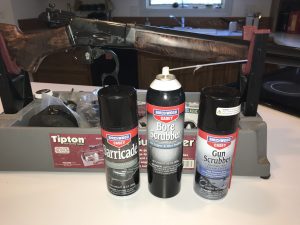 Boddington does most of his gun cleaning at the range, making sure he includes cleaning gear with his range kit. The only advantage to doing it at the range: After cleaning you can fire fouling shots, and then your rifle is ready to go hunting.
Boddington does most of his gun cleaning at the range, making sure he includes cleaning gear with his range kit. The only advantage to doing it at the range: After cleaning you can fire fouling shots, and then your rifle is ready to go hunting.
I wouldn’t wish to admit this in front of my old Drill Instructor, but I don’t necessarily clean my rifles every time I fire them. It depends on the conditions, and how many shots down the barrel since the last cleaning. Instead, here’s what I do: I take my cleaning gear to the range for the last practice or zero session before I take a rifle on a hunt. Then, when I’m just about done and I’m happy with the zero and the load, I clean thoroughly on the range. Most rifles put the first couple of shots from a freshly-cleaned barrel to a different point of impact than after the barrel is slightly fouled (which, with my rifles, is a more natural state!). The difference is often slight, but can be a couple of inches. So, after cleaning and when I’m all done, I fire two or three “fouling shots.” Then I’m really done, so I’m ready to pack up.
Except for one more thing. Toward the tail end of that last range session before a hunt, it’s wise to run all the cartridges you’re taking with you through the magazine and into and out of the chamber. Just recently I was in camp with a gent who had a gorgeous rifle. Half his ammo was somebody else’s handloads—and they wouldn’t chamber in his rifle. Yeah, I know how silly this sounds, but obviously it happens. I don’t shoot other people’s handloads, and I don’t loan mine to anyone else. Problems with factory loads are rare, but once in a while you run into a dented case, bad case mouth, etc. It’s wise to visually check all ammo for a hunt, first to make sure everything matches, and then to make sure all cartridges feed and chamber in your rifle.
PRACTICE SHOOTING. Shooting practice really should be ongoing and continuous. As with conditioning, no one can say how much is enough, but nobody can spend too much time practicing. The only caveat to that is don’t overdo it: If you beat yourself up and acquire a flinch it’s gonna take a lot of work to undo it. So, practice smart. With hard-kicking rifles, limit your exposure per range session. Half a dozen or ten shots may be plenty, and twenty is probably too much. Intersperse with a good old .22 or a mild-recoiling varmint rifle.
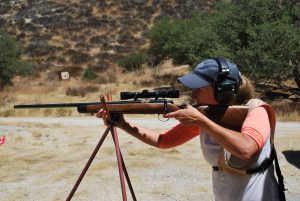 Much effective practice shooting can be done with a .22, minimizing recoil and cost, and reducing barrel-cooling time on summer days. Everything you need to know about shooting over sticks can be learned with a .22.
Much effective practice shooting can be done with a .22, minimizing recoil and cost, and reducing barrel-cooling time on summer days. Everything you need to know about shooting over sticks can be learned with a .22.
A solid benchrest is essential for checking zero and evaluating loads, but in my view shooting off the bench isn’t practice for hunting. Get away from the bench and do as much shooting as you possibly can from positions you might actually use in the field: Shooting sticks, bipods, impromptu rests, and the good old basic NRA shooting positions of prone, kneeling, sitting, and standing. Whatever your hunting rifle happens to be, you need to shoot it enough to be completely familiar and comfortable, but a lot of this practice shooting can be done effectively with a good old .22, with no recoil and little cost.
I love long summer days, when you can start shooting early and stay late if you wish. However, summer heat changes the game. Barrels heat up quickly, and the pencil-thin barrels common on light sporters today heat up very quickly. Accuracy can deteriorate fast, so it’s important to be patient and plan on spending a lot of time waiting for barrels to cool. How long, and after how many shots depends on ambient temperature, bullet velocity, and barrel thickness, but you can’t learn anything shooting a hot barrel. Take your time, and spend more time shooting your .22.


